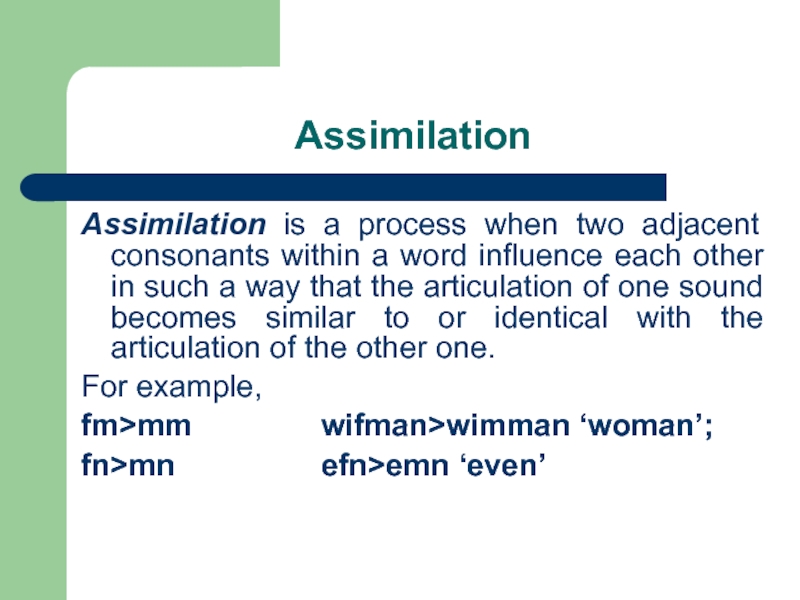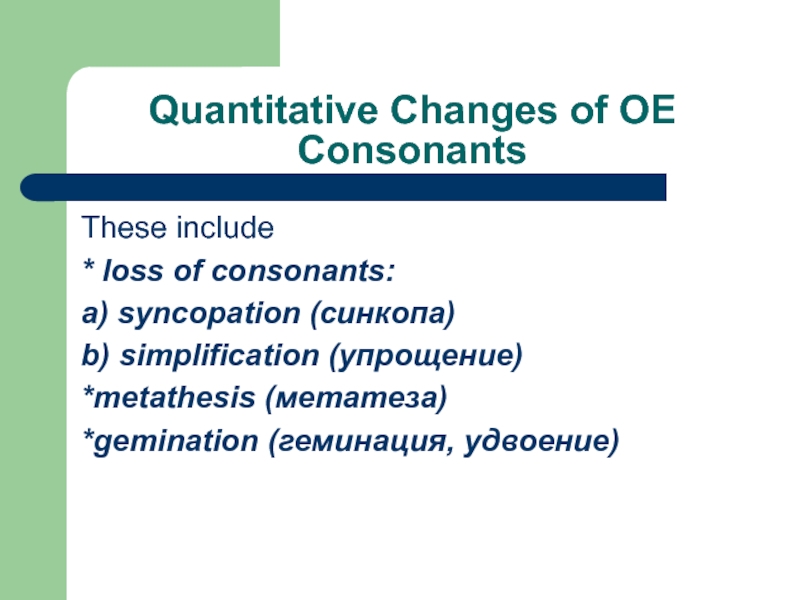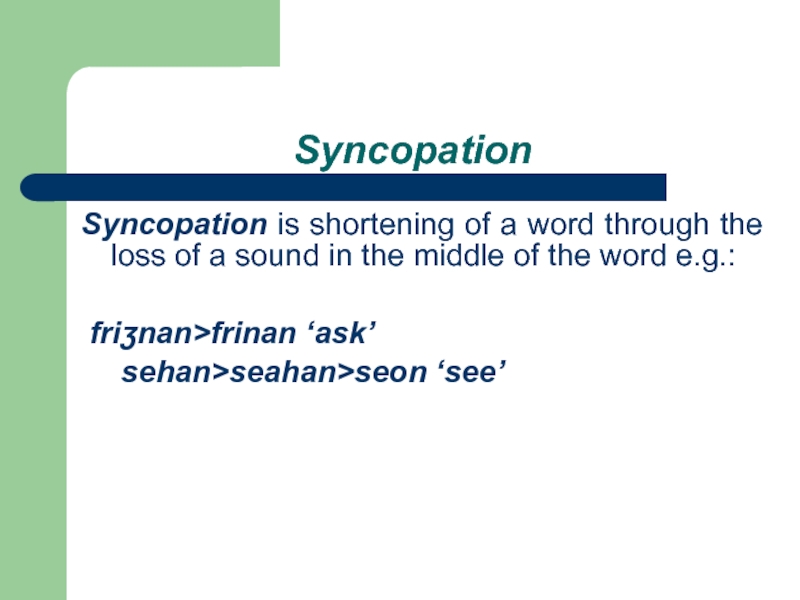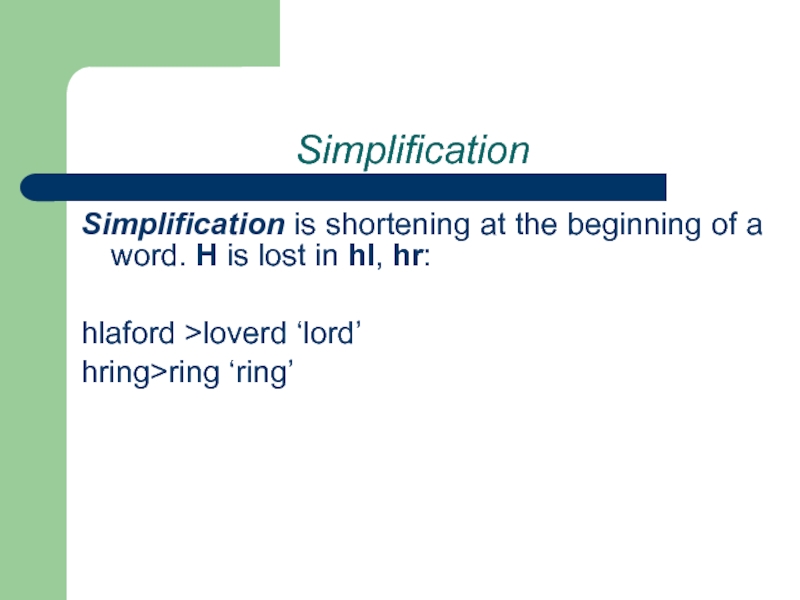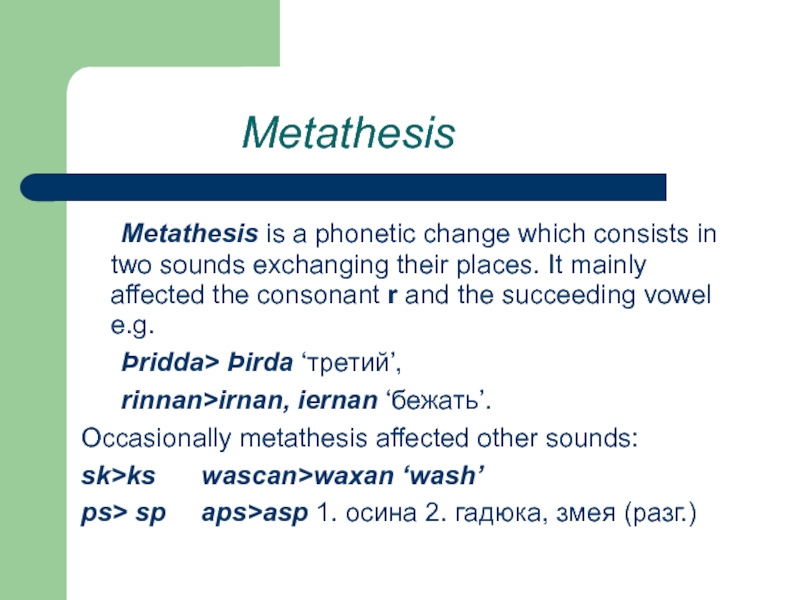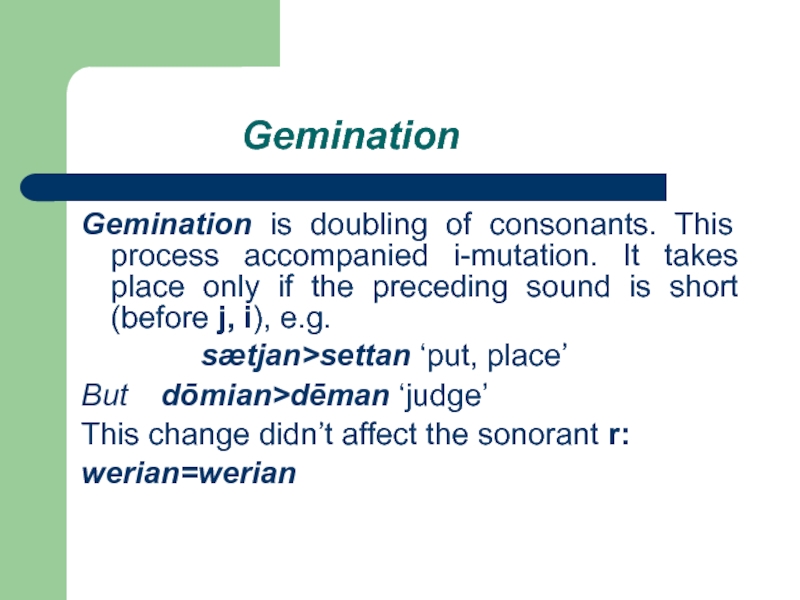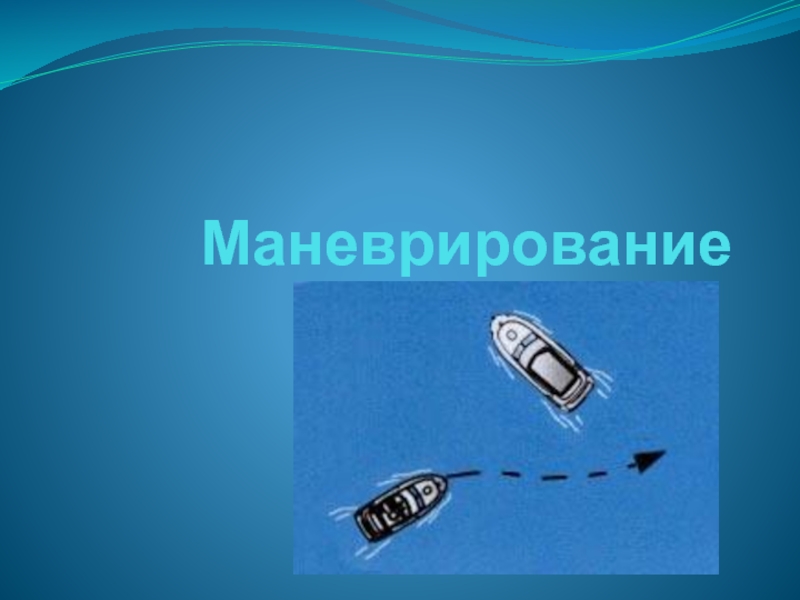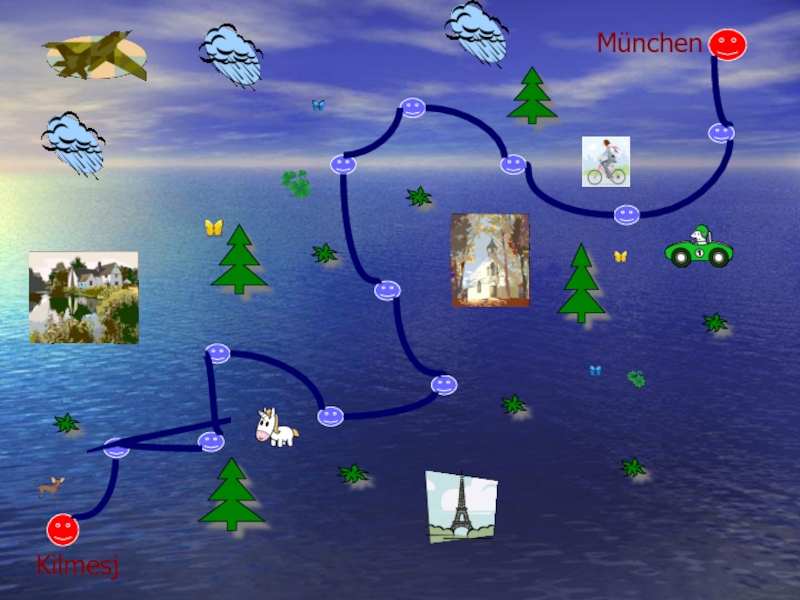- Главная
- Разное
- Дизайн
- Бизнес и предпринимательство
- Аналитика
- Образование
- Развлечения
- Красота и здоровье
- Финансы
- Государство
- Путешествия
- Спорт
- Недвижимость
- Армия
- Графика
- Культурология
- Еда и кулинария
- Лингвистика
- Английский язык
- Астрономия
- Алгебра
- Биология
- География
- Детские презентации
- Информатика
- История
- Литература
- Маркетинг
- Математика
- Медицина
- Менеджмент
- Музыка
- МХК
- Немецкий язык
- ОБЖ
- Обществознание
- Окружающий мир
- Педагогика
- Русский язык
- Технология
- Физика
- Философия
- Химия
- Шаблоны, картинки для презентаций
- Экология
- Экономика
- Юриспруденция
LECTURE 2 Old English Phonetic System and Phonetic Changes. Lecture 2 презентация
Содержание
- 1. LECTURE 2 Old English Phonetic System and Phonetic Changes. Lecture 2
- 2. 1. Old English Vowels and Consonants.
- 3. VOWELS The monophthongs are: a æ e
- 4. CONSONANTS The system of consonants in
- 5. CONSONANTS 2. The absence of affricates (аффрикаты)
- 6. CONSONANTS hlāf, oft [f] – hlaford, lifde [v]
- 7. CONSONANTS b) the letter ʒ was pronounced
- 8. CONSONANTS 4. Double consonants were read
- 9. 2. Phonetic Changes in Old English Vowels.
- 10. FRACTURE OE fracture is diphthongization of short
- 11. FRACTURE e>eo before the clusters ‘r, l,
- 12. PALATALIZATION Palatalization is diphthongization after palatal consonants
- 13. MUTATION (UMLAUT) Mutation is the change of
- 14. I-MUTATION The most important type of mutation
- 15. I-MUTATION When the speaker begins to articulate
- 16. BACK MUTATION Another type of mutation was
- 17. BACK MUTATION These are the examples of
- 18. MUTATION BEFORE h There’s no satisfactory explanation
- 19. Quantitative Changes in OE Vowels Quantitative
- 20. LENGTHENING 2. It took place
- 21. LENGTHENING 3. Lengthening took place in case
- 22. 3. Phonetic Changes in OE Consonants
- 23. Voicing and Devoicing of Fricatives In OE
- 24. Palatalization The velar consonants [k, g, g:,
- 25. Assimilation Assimilation is a process when two
- 26. Quantitative Сhanges of OE Consonants These
- 27. Syncopation Syncopation is shortening of a
- 28. Simplification Simplification is shortening at the beginning
- 29. Metathesis Metathesis is a phonetic change
- 30. Gemination Gemination is doubling of consonants. This
Слайд 21. Old English Vowels
and Consonants.
The Old English sound system, consisting
of vowels and consonants, developed from the PG (Proto-Germanic) system.
Old English vowels are divided into monophthongs and diphthongs. They could be long and short.
Old English vowels are divided into monophthongs and diphthongs. They could be long and short.
Слайд 3 VOWELS
The monophthongs are: a æ e i u y o
å ā
ǣ ē ī ū ȳ ō
The diphthongs are: ea eo ie io
ēā ēō īē īō
In OE there existed a parallelism between short and long vowels (except for a). In the diphthong the 2nd element was more open than the first.
The diphthongs are: ea eo ie io
ēā ēō īē īō
In OE there existed a parallelism between short and long vowels (except for a). In the diphthong the 2nd element was more open than the first.
Слайд 4 CONSONANTS
The system of consonants in OE manifested the following peculiarities.
1. The
consonants were divided into:
labial (губные) sounds – p, b, m, w, f, v;
velar (задненёбные) and palatal (нёбные) – k, h, g, ɣ, j;
dental (зубные) – t, d, r, l, n, s, z, θ,ð.
labial (губные) sounds – p, b, m, w, f, v;
velar (задненёбные) and palatal (нёбные) – k, h, g, ɣ, j;
dental (зубные) – t, d, r, l, n, s, z, θ,ð.
Слайд 5 CONSONANTS
2. The absence of affricates (аффрикаты) and sibilants (свистящие, шипящие).
3. Dependence
of the quality of the consonants on the environment (окружение) in the word:
a) phonemes, denoted by the letters f, þ (ð), s could be voiced or voiceless. They were voiced in the intervocal position. This position could be made up of a vowel and a voiced consonant.
a) phonemes, denoted by the letters f, þ (ð), s could be voiced or voiceless. They were voiced in the intervocal position. This position could be made up of a vowel and a voiced consonant.
Слайд 6 CONSONANTS
hlāf, oft [f] – hlaford, lifde [v]
tōþ [θ] – tōþes [ð]
ʒōs [s] – ʒōses [z]
But
doubled consonants were always voicelss: offrian [f:] (предлагать), sceþþan [θ:] (вредить), cyssan [s:] (целовать).
Слайд 7 CONSONANTS
b) the letter ʒ was pronounced in 3 ways.
as the
voiced velar plosive variant [g] at the beginning of the word, before back vowels (a, o, u) and consonants, in the middle of the word after n:
[g] – ʒōd, ʒrētan, ʒanʒan
as the voiced velar fricative variant [ɣ] in the middle of the word after back vowels and consonants [r, l]:
[ɣ] – daʒas, sloʒ, sorʒ, folʒan
as the voiced palatal fricative variant [j] before and after front vowels:
[j] – ʒēār, dæʒ
[g] – ʒōd, ʒrētan, ʒanʒan
as the voiced velar fricative variant [ɣ] in the middle of the word after back vowels and consonants [r, l]:
[ɣ] – daʒas, sloʒ, sorʒ, folʒan
as the voiced palatal fricative variant [j] before and after front vowels:
[j] – ʒēār, dæʒ
Слайд 8 CONSONANTS
4. Double consonants were read as long: settian [t:], steppan [p:].
5.
Instead of doubled ʒ, cʒ was written: lecʒan [g’:] (положить)
6. The prefix ʒe- was read as [je] and did not influence the pronunciation of the following consonant: ʒeseʒlian [je 'sejlian].
6. The prefix ʒe- was read as [je] and did not influence the pronunciation of the following consonant: ʒeseʒlian [je 'sejlian].
Слайд 92. Phonetic Changes in Old English Vowels.
The phonetic changes in the
vowels system were qualitative (качественные) and quantitative (количественные).
The qualitative changes are
*fracture (breaking) (преломление)
*palatalization (палатализация)
*mutation/umlaut (умлаут)
The qualitative changes are
*fracture (breaking) (преломление)
*palatalization (палатализация)
*mutation/umlaut (умлаут)
Слайд 10 FRACTURE
OE fracture is diphthongization of short vowels before certain consonant clusters
(кластеры, группы).
æ >ea before ‘r +consonant’, ‘l+consonant’, ‘h+consonant’ and before final h:
ærm>earm ‘arm’, æld>eald ‘old’, æhta>eahta ‘eight’, sæh>seah ‘saw’.
æ >ea before ‘r +consonant’, ‘l+consonant’, ‘h+consonant’ and before final h:
ærm>earm ‘arm’, æld>eald ‘old’, æhta>eahta ‘eight’, sæh>seah ‘saw’.
Слайд 11 FRACTURE
e>eo before the clusters ‘r, l, h+consonant’, and h final:
herte>heorte
‘heart’, melcan>meocan ‘milk’(v), selh>seolh ‘seal’, feh>feoh ‘cattle’, ‘property’.
The essence of fracture is that the front vowels are partially assimilated to the following hard consonant by forming a glide, which combines with the vowel to form a diphthong.
The essence of fracture is that the front vowels are partially assimilated to the following hard consonant by forming a glide, which combines with the vowel to form a diphthong.
Слайд 12 PALATALIZATION
Palatalization is diphthongization after palatal consonants [j,k] and the cluster [sk].
e>ie: ʒefan>ʒiefan ‘give’, ʒeldan>ʒieldan ‘pay’
æ>ea: ʒæf>ʒeaf ‘gave’, cæster>ceaster ‘camp’, scæl>sceal ‘shall’
æ>ea: ʒæfon>ʒeafon ‘gave’ (pl.)
a>ea: scacan>sceacan ‘shake’
o>eo: scort>sceort ‘short”
Слайд 13 MUTATION (UMLAUT)
Mutation is the change of one vowel to another through
the influence of a vowel in the succeeding syllable (последующий слог).
It was of three types:
1) i-mutation (palatal mutation)
2) back mutation
3) mutation before h
It was of three types:
1) i-mutation (palatal mutation)
2) back mutation
3) mutation before h
Слайд 14 I-MUTATION
The most important type of mutation is that caused by an
i (j) of the following syllable. Let’s study the mechanism of i-mutation, taking the change fullian>fyllan ‘fill’ as an example. The vowel u is articulated by raising the back of the tongue together with rounding the lips. The sound i requires raising the front of the tongue.
Слайд 15 I-MUTATION
When the speaker begins to articulate the u, he at the
same time anticipates (предвидеть)the articulation needed for i and raises the front of the tongue instead of its back. The lip-rounding is preserved. The result is the vowel y.
Слайд 16 BACK MUTATION
Another type of mutation was caused by a back vowel
(a, o, u) of the following syllable. The essence of it is the following. The articulation of the back vowel is anticipated in the preceding front vowel, which accordingly develops into a diphthong.
Слайд 17BACK MUTATION
These are the examples of back-mutation:
i>io hira>hiora (heora)‘their’, sifon>siofon ‘seven’
e>eo herot>heorot ‘heart’
a>ea saru>searu
‘armour’
Слайд 18MUTATION BEFORE h
There’s no satisfactory explanation for the essence of this
type of mutation. This is an example of such a change.
naht>neaht, nieht, niht, nyht ‘night’
It may be due to a palatal quality of the h or due to an i which was probably a case ending (падежное окончание) in the original type of declension (склонение) to which the word belonged.
naht>neaht, nieht, niht, nyht ‘night’
It may be due to a palatal quality of the h or due to an i which was probably a case ending (падежное окончание) in the original type of declension (склонение) to which the word belonged.
Слайд 19Quantitative Changes in OE Vowels
Quantitative changes in OE vowels are
represented by lengthening.
Lengthening took place in certain positions in the 9th century.
1. Vowels are lengthened before the clusters ld, nd, mb:
cild>cīld ‘child’
bindan>bīndan ‘bind’
climban>clīmban ‘climb’
But if the cluster was followed by another consonant, lengthening did not take place, as in cildru ‘children’.
Lengthening took place in certain positions in the 9th century.
1. Vowels are lengthened before the clusters ld, nd, mb:
cild>cīld ‘child’
bindan>bīndan ‘bind’
climban>clīmban ‘climb’
But if the cluster was followed by another consonant, lengthening did not take place, as in cildru ‘children’.
Слайд 20LENGTHENING
2. It took place if some consonants were lost.
a) The
vowels were lengthened when ʒ was lost before d,n.
sæʒde>sǣde ‘said’
mæʒden>mǣden ‘maiden’
b) The vowels were lengthened when m,n were lost before f, s, Þ, h.
bronhte>brōhte ‘brought’, finf>fīf ‘five’, uns>ūs ‘us’, onÞer>ōÞer ‘other’.
sæʒde>sǣde ‘said’
mæʒden>mǣden ‘maiden’
b) The vowels were lengthened when m,n were lost before f, s, Þ, h.
bronhte>brōhte ‘brought’, finf>fīf ‘five’, uns>ūs ‘us’, onÞer>ōÞer ‘other’.
Слайд 21LENGTHENING
3. Lengthening took place in case of contraction (стяжение). If, after
a consonant had dropped, two vowels met inside a word, they usually contracted into one long vowel.
ah+vowel>eah+vowel>ea
slahan>sleahan>slēāh ‘slay’ (бить, избивать)
eh, ih+vowel>eoh+vowel>eo sehan>seohan>sēōn ‘see’
oh+vowel>o fohan>fōn ‘catch’
ah+vowel>eah+vowel>ea
slahan>sleahan>slēāh ‘slay’ (бить, избивать)
eh, ih+vowel>eoh+vowel>eo sehan>seohan>sēōn ‘see’
oh+vowel>o fohan>fōn ‘catch’
Слайд 223. Phonetic Changes in OE Consonants
Qualitative changes:
*voicing and devoicing of fricatives
*palatalization
*assimilation.
Слайд 23Voicing and Devoicing of Fricatives
In OE the fricatives f, s, Þ
were subjected (подверглись) to a process of voicing and devoicing. They became voiced intervocally – between vowels, sonorants and voiced consonants. In other positions they remained voiceless.
weorÞan – (становиться) [ð],
wearÞ (стал) - [θ]
weorÞan – (становиться) [ð],
wearÞ (стал) - [θ]
Слайд 24Palatalization
The velar consonants [k, g, g:, х] were palatalized before a
front vowel and approached (приближаться) affricates in Late OE.
k>k’>ʧ cild ‘child’
sk>sk’>ʃ scip ‘ship’
g(g:)>g’(g:’)>dʒ senʒean ‘singe’
brycʒ ‘bridge’
k>k’>ʧ cild ‘child’
sk>sk’>ʃ scip ‘ship’
g(g:)>g’(g:’)>dʒ senʒean ‘singe’
brycʒ ‘bridge’
Слайд 25Assimilation
Assimilation is a process when two adjacent consonants within a word
influence each other in such a way that the articulation of one sound becomes similar to or identical with the articulation of the other one.
For example,
fm>mm wifman>wimman ‘woman’;
fn>mn efn>emn ‘even’
For example,
fm>mm wifman>wimman ‘woman’;
fn>mn efn>emn ‘even’
Слайд 26Quantitative Сhanges of OE Consonants
These include
* loss of consonants:
a) syncopation
(синкопа)
b) simplification (упрощение)
*metathesis (метатеза)
*gemination (геминация, удвоение)
b) simplification (упрощение)
*metathesis (метатеза)
*gemination (геминация, удвоение)
Слайд 27Syncopation
Syncopation is shortening of a word through the loss of
a sound in the middle of the word e.g.:
friʒnan>frinan ‘ask’
sehan>seahan>seon ‘see’
friʒnan>frinan ‘ask’
sehan>seahan>seon ‘see’
Слайд 28Simplification
Simplification is shortening at the beginning of a word. H is
lost in hl, hr:
hlaford >loverd ‘lord’
hring>ring ‘ring’
hlaford >loverd ‘lord’
hring>ring ‘ring’
Слайд 29 Metathesis
Metathesis is a phonetic change which consists in two sounds
exchanging their places. It mainly affected the consonant r and the succeeding vowel e.g.
Þridda> Þirda ‘третий’,
rinnan>irnan, iernan ‘бежать’.
Occasionally metathesis affected other sounds:
sk>ks wascan>waxan ‘wash’
ps> sp aps>asp 1. осина 2. гадюка, змея (разг.)
Þridda> Þirda ‘третий’,
rinnan>irnan, iernan ‘бежать’.
Occasionally metathesis affected other sounds:
sk>ks wascan>waxan ‘wash’
ps> sp aps>asp 1. осина 2. гадюка, змея (разг.)
Слайд 30 Gemination
Gemination is doubling of consonants. This process accompanied i-mutation. It takes
place only if the preceding sound is short (before j, i), e.g.
sætjan>settan ‘put, place’
But dōmian>dēman ‘judge’
This change didn’t affect the sonorant r:
werian=werian
sætjan>settan ‘put, place’
But dōmian>dēman ‘judge’
This change didn’t affect the sonorant r:
werian=werian
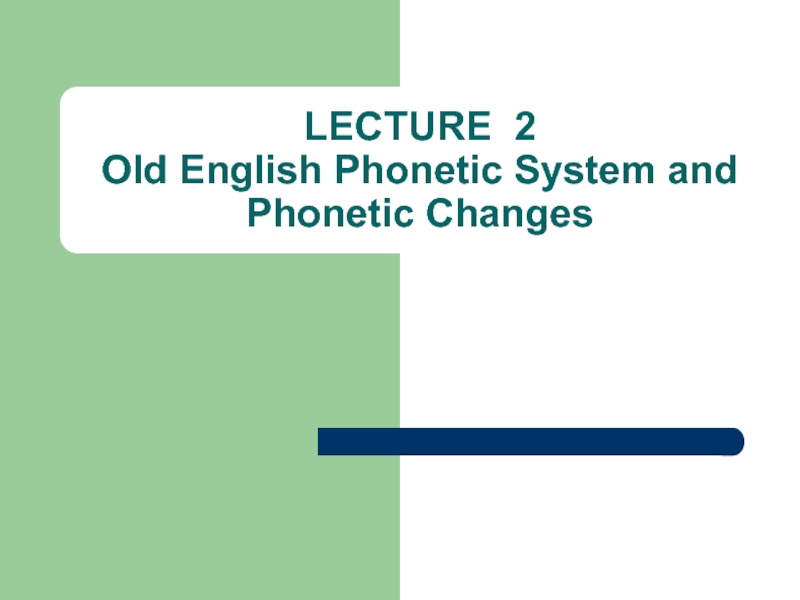
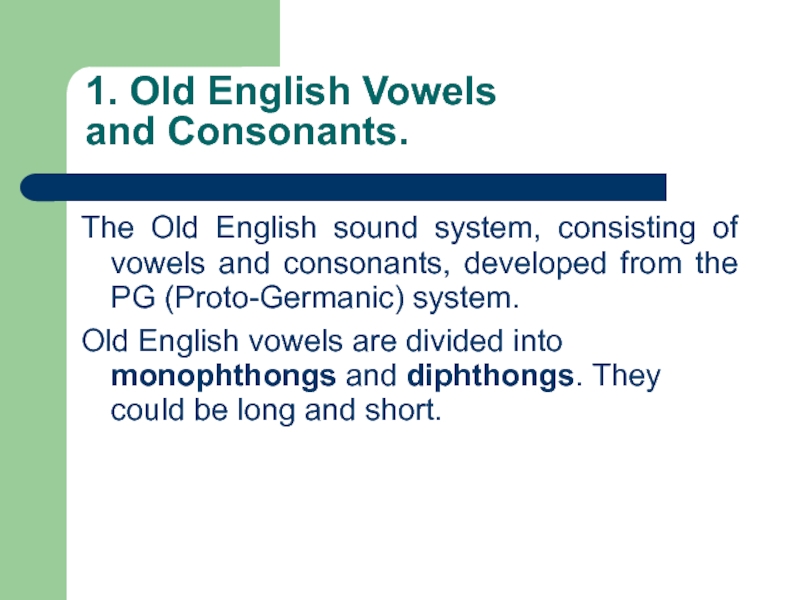
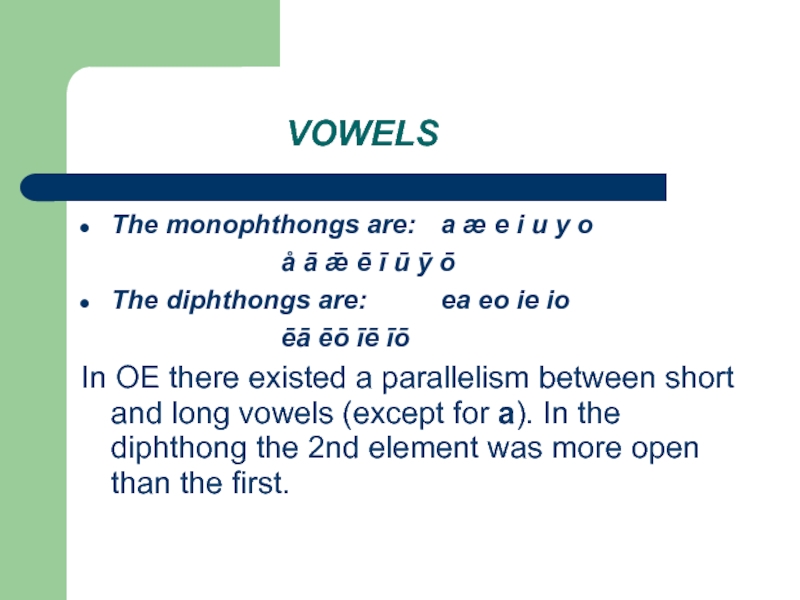
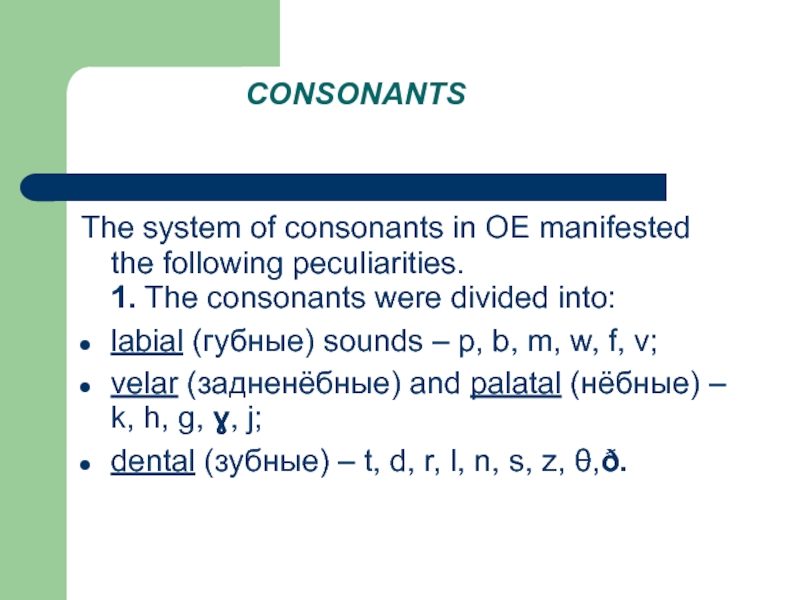
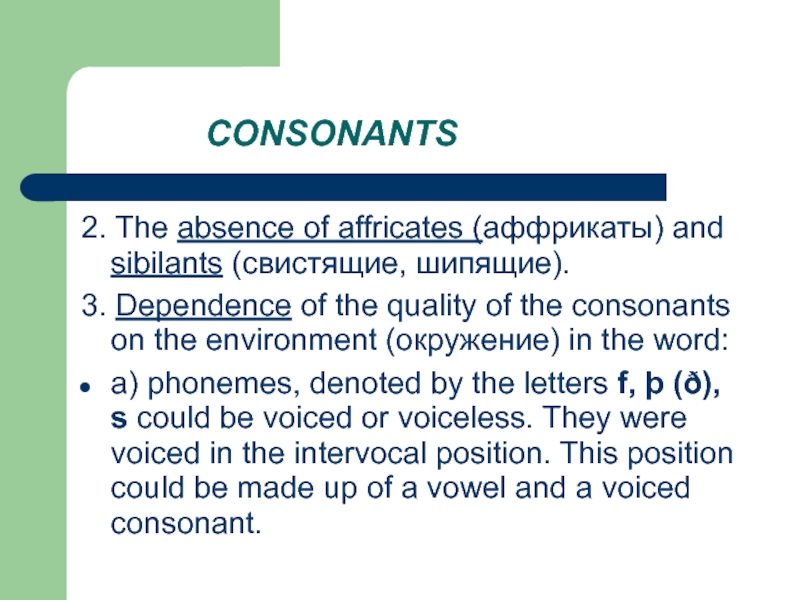
![CONSONANTS hlāf, oft [f] – hlaford, lifde [v] tōþ [θ] – tōþes [ð] ʒōs [s] – ʒōses [z]But doubled consonants were always](/img/tmb/3/278303/f7e9e9a694d60e2e0e5d75669301b861-800x.jpg)
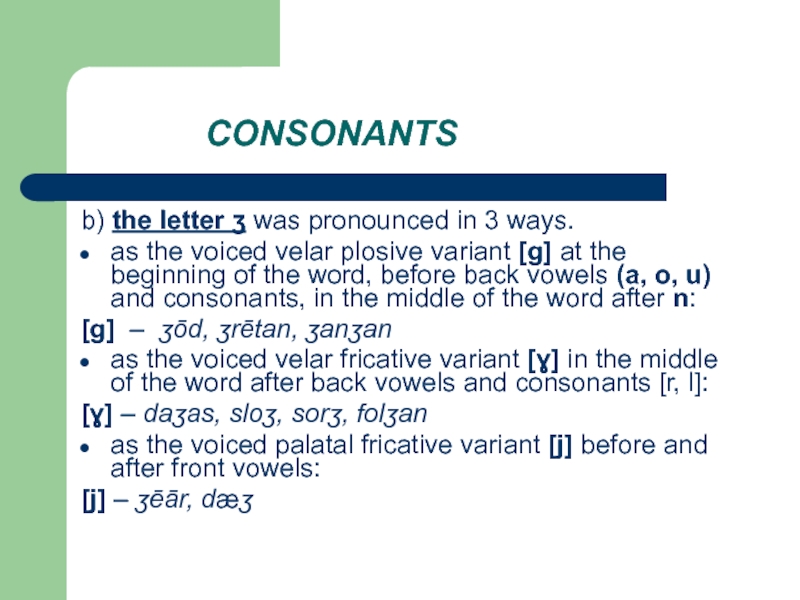
![CONSONANTS 4. Double consonants were read as long: settian [t:], steppan [p:]. 5. Instead of doubled](/img/tmb/3/278303/a5498cf3968a5fd4ab7206470d1d89c1-800x.jpg)

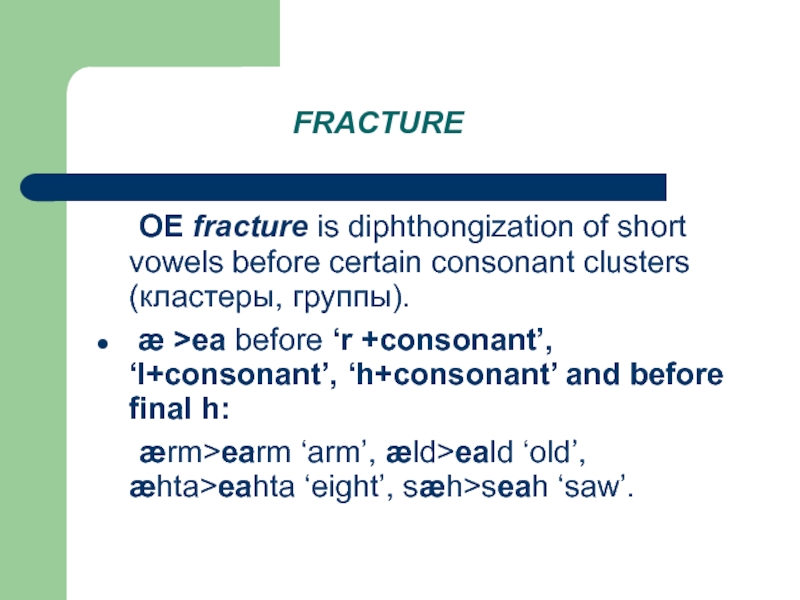
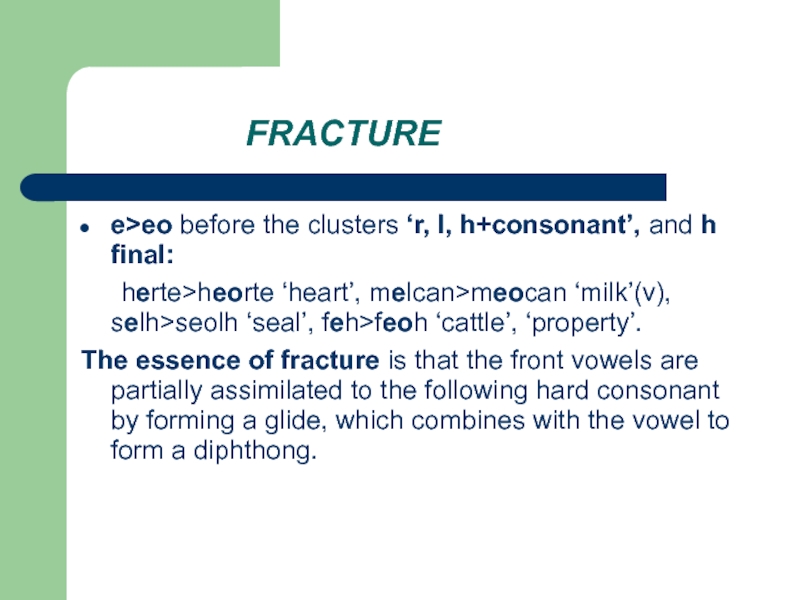
![PALATALIZATIONPalatalization is diphthongization after palatal consonants [j,k] and the cluster [sk]. e>ie: ʒefan>ʒiefan ‘give’, ʒeldan>ʒieldan](/img/tmb/3/278303/286afb1dfdd910160a2972951c78ac1b-800x.jpg)
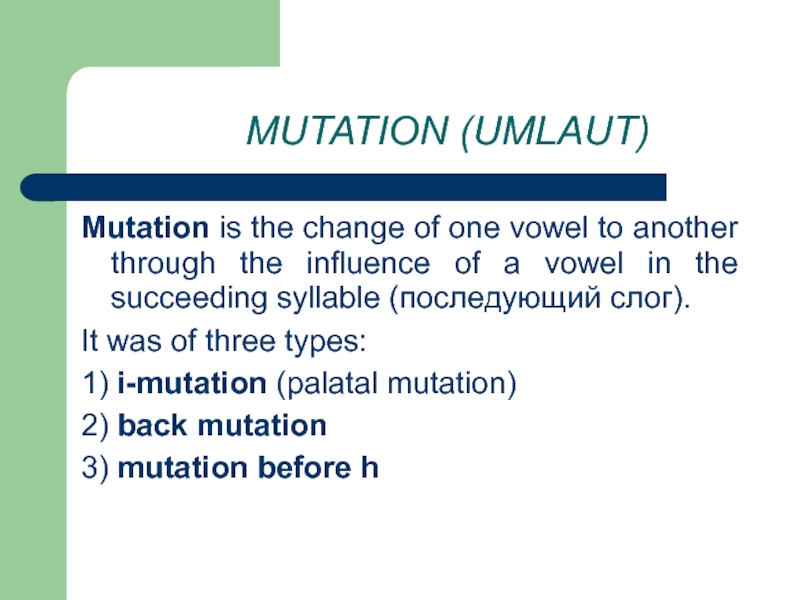
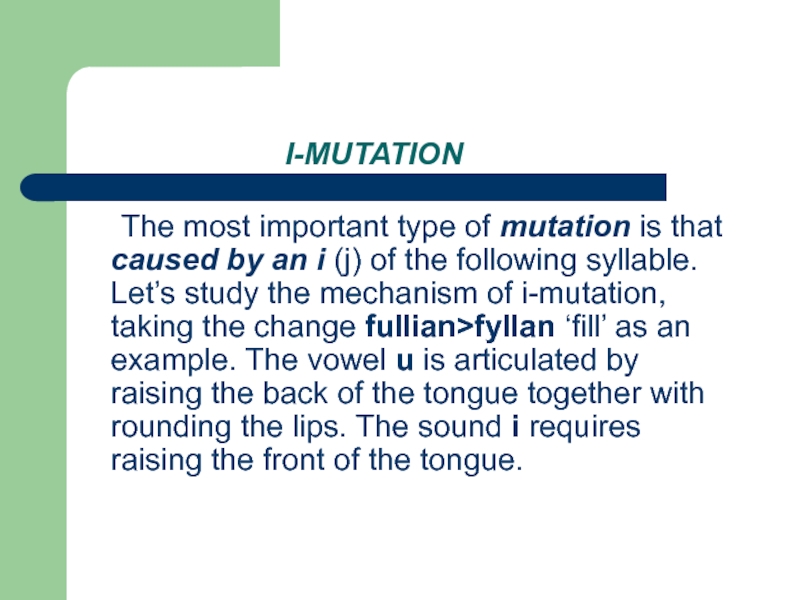
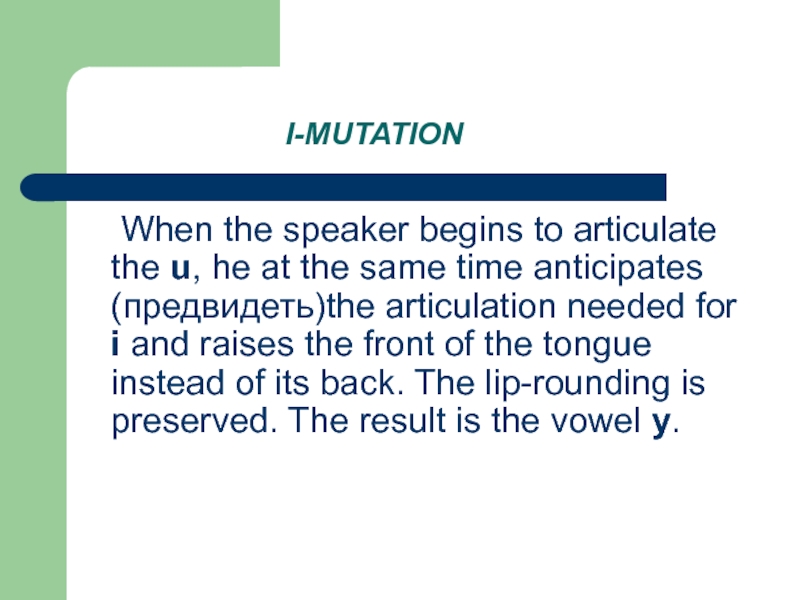


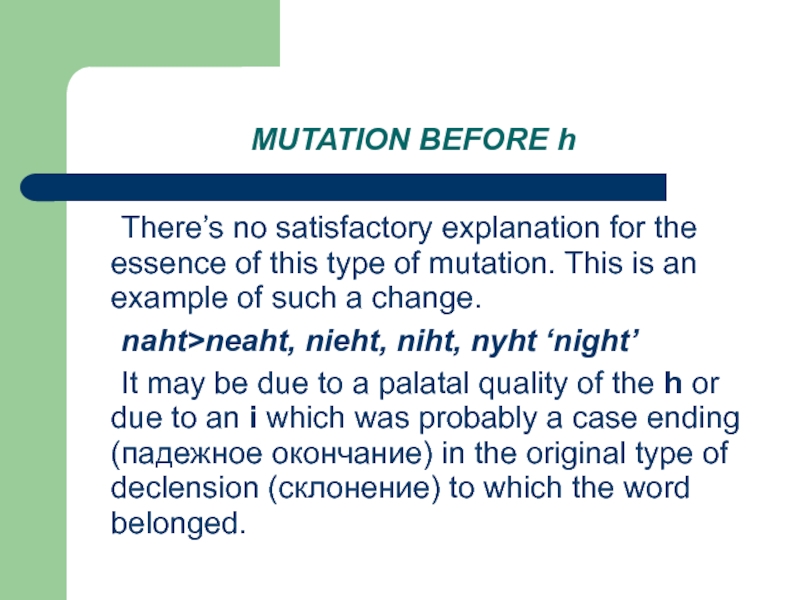
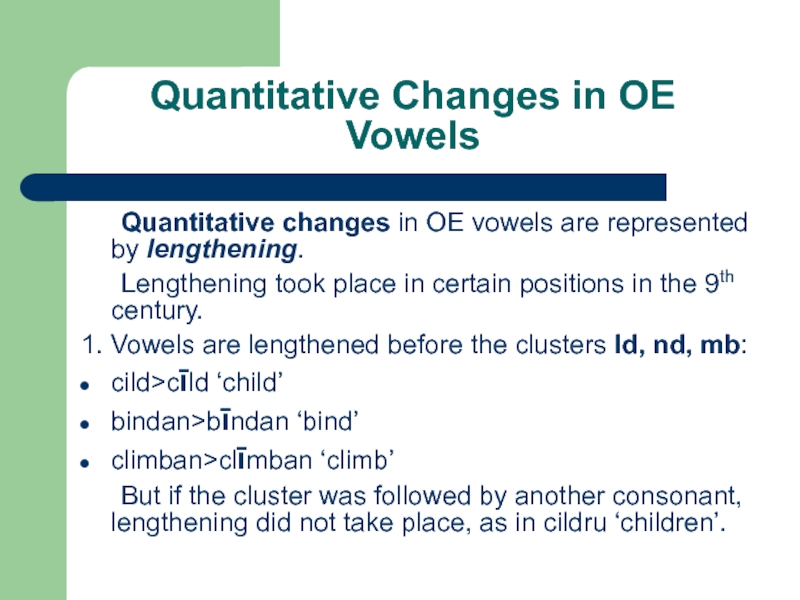
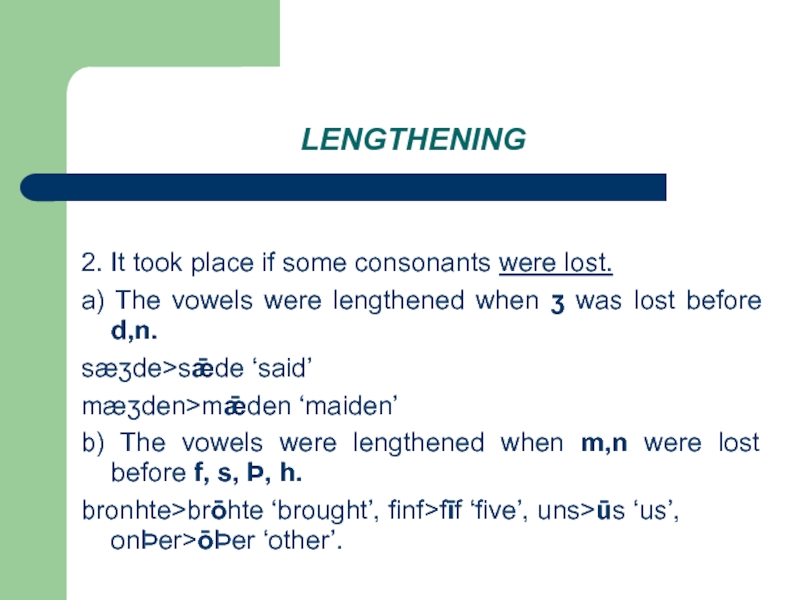
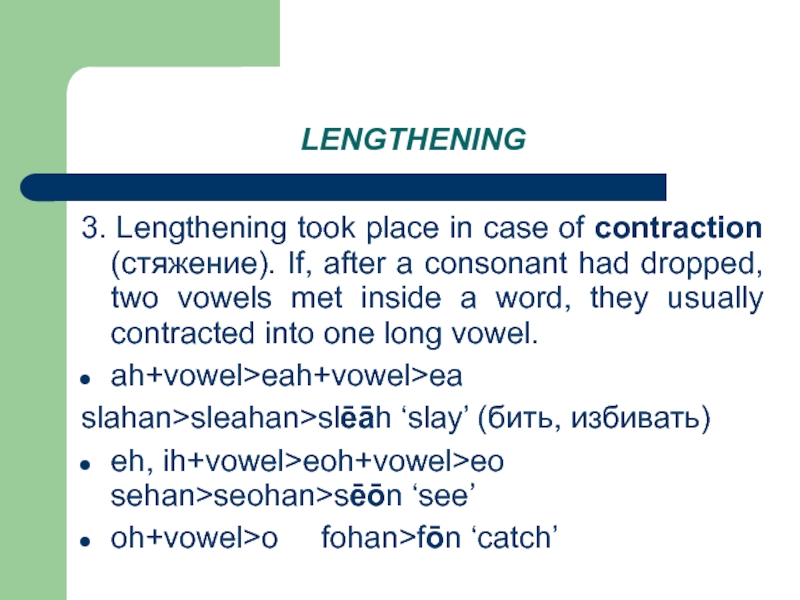
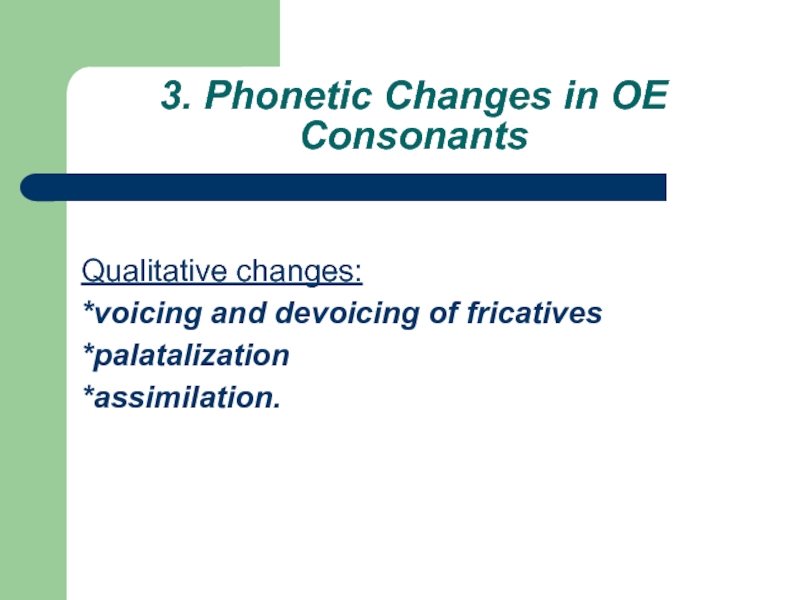

![PalatalizationThe velar consonants [k, g, g:, х] were palatalized before a front vowel and approached](/img/tmb/3/278303/2c700002b36974b7b89e3bd83a3911e1-800x.jpg)
